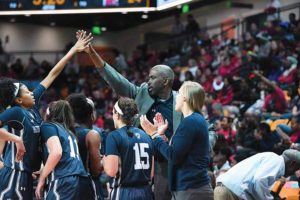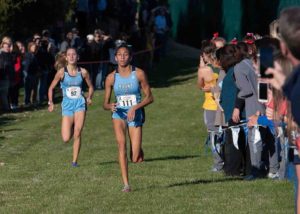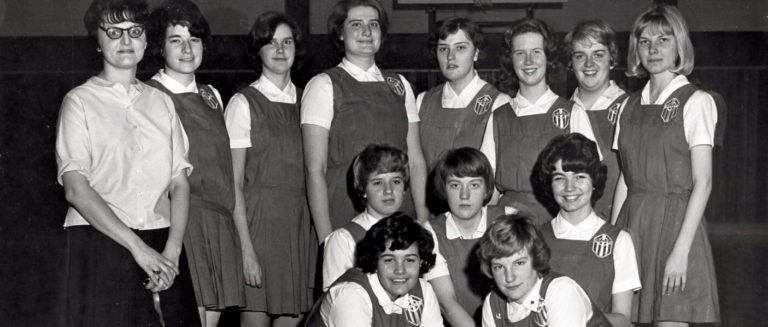

Mary Ella Marion enjoyed a Hall of Fame athletic career at what was then Loyola College, before its women’s teams even had the opportunity to compete for NCAA championships.
Now all-girls Mercy High School, her prep alma mater and where she’s the dean of students, is constructing an artificial turf field as part of $10 million in recent capital improvements.
After a five-year absence, Marion is back as the Magic’s basketball coach. Come Feb. 1, when Mercy meets the Institute of Notre Dame in the 53rd installment of “The Game,” her opposite will also attest to the fact that when it comes to sports, girls have certainly come a long way.
Robert DuBose moved the Penguins up to the Interscholastic Athletic Association of Maryland A Conference this winter, despite key losses to graduation, most notably his daughter, Madison.
Watching her develop and head off to play college basketball and run track and field for LIU Post in New York, Dubose couldn’t help but think of his late mother, Mary.
“She was 6-feet tall, and built like Madison,” he said. “She was a left-hander, and wore glasses, just like Madison. She was a good athlete, but there weren’t a lot of opportunities for her growing up in South Carolina. She used to tell the boys, ‘If I can’t get on the basketball court with you, I can beat you in the field.’ She was a good BB shooter.”

Mary Dubose’s experience was hardly unique.
The IND-Mercy tradition began in 1967, when the notion of females exerting themselves was discouraged.
Girls’ basketball in parts of the United States was 6-on-6, with offensive and defensive specialists restricted to one half of the court. Through 1968, the longest footrace for women at the Summer Olympics was 800 meters. It wasn’t until 1971 that the Association for Intercollegiate Athletics, eventually superseded by the NCAA, was formed.
Most seasons, Dubose takes IND to a tournament in Washington, D.C., that celebrates Title IX, the federal civil rights law enacted in 1972 that prohibited discrimination based on sex. In the short term, it opened doors for girls’ athletics. Over the long haul, it made the U.S. the leader in the women’s medal count at the Summer Olympics.
“The Game” nonetheless remained something of a local novelty, as local Catholic girls’ athletics, with the exception of the occasional dynasty, such as Towson Catholic basketball in the early 1980s, lagged behind public school jurisdictions, first Baltimore County, and then Anne Arundel County.
Contrast that to this winter’s area rankings by The Sun, which in mid-January showed a clean Catholic sweep, with the girls from St. Frances Academy (basketball) and Mount de Sales Academy (indoor track and field) joining the boys from Calvert Hall (indoor track) and Mount St. Joseph (basketball and wrestling) atop area consideration.
No one has a better perspective on that altered landscape than Mary Bartel.
She was hired by Notre Dame Preparatory School in 1981, the day after she had graduated from what is now Towson University. Now chairwoman of the physical education department, Bartel developed a championship lacrosse team, coached volleyball and basketball, and taught – all while serving as athletic director for 25 years.
“When you consider the number of girls participating, the number of programs, and the number of facilities you have to manage, the athletic director position has become a full-time job,” said Bartel, who went to Perry Hall High, she noted, when “Baltimore County was getting it right.”

The emphasis on athletics gradually grew among NDP and its peers.
“When we realized that athletics played a part in admissions and opened additional avenues for our graduates on the college front, things changed,” Bartel said.
Byproducts range from NDP having the state’s top-ranked lacrosse team, to a variety of No. 1 programs at Archbishop Spalding High School, to IND having four alumnae rowing in college.
On the facilities front, Maryvale Preparatory School had a championship track team before it built a track. Now Mercy, which reached the A Conference soccer final in 2016, is advancing both its campus and access to it with its artificial turf facility.
It’s all a heady experience for Marion, the Magic coach, who remembers playing her first college basketball game for Loyola in a skirt.
“We’re talking about a top-of-the-line field,” Marion said. “Just the continuity aspect, being able to practice and play if it’s raining, that’s huge. It’s another way to level the playing field.”



